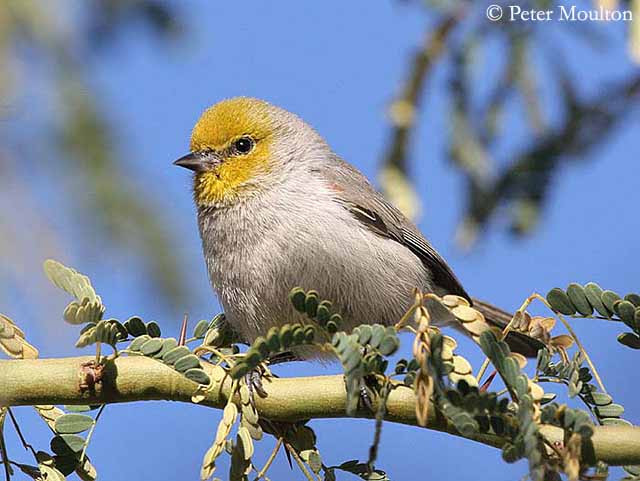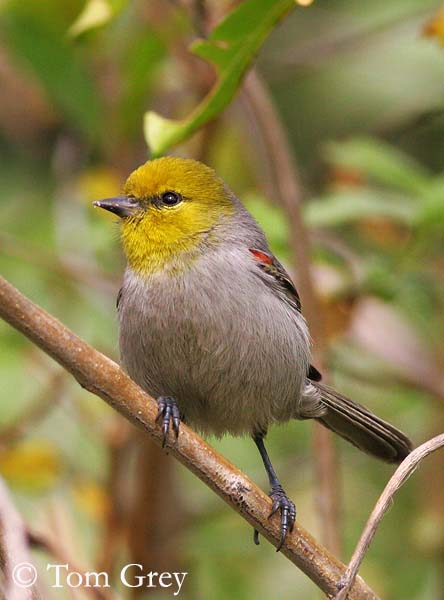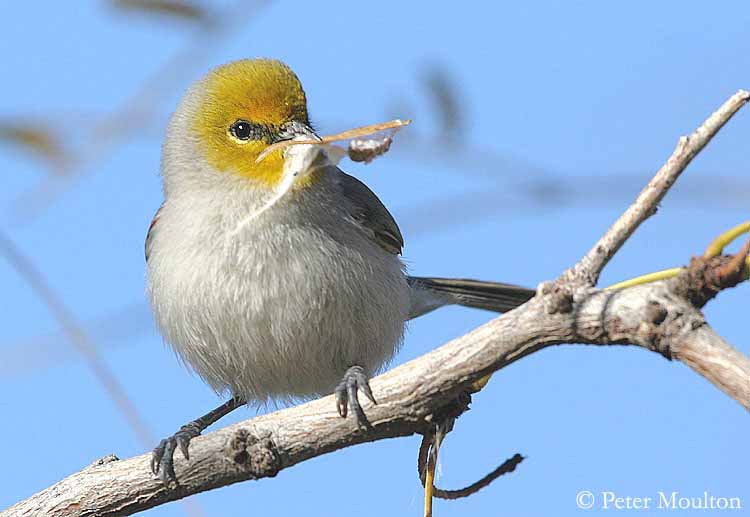
Verdin
Auriparus flaviceps
Passeriforme Order – Polioptilidae Family
BIOMETRICS :
Length: 9-11 cm
Weight: 5-8 g
LONGEVITY: up to 5 years
DESCRIPTION:
Verdin is among the smallest of North American songbirds.

Adult has dull grey or ashy upperparts. Wings and tail feathers show pale edges. We can see conspicuous chestnut shoulder patch.
Underparts are pale grey to white.
Head is yellow on forecrown, chin and throat. This colour may vary from olivaceous yellow to bright yellow in male. Lores are dark. According to the location, some birds may have indistinct orange to chestnut spot on forecrown. Bill is conical, pointed and blackish. Eyes are dark brown. Legs and feet are blackish.
Both sexes are similar.

Juvenile is similar to adults, but it lacks yellow head and chestnut shoulder patch. It has brownish upperparts, and underparts may be slightly tinged with yellow.
VOICE: SOUNDS BY XENO-CANTO
Verdin’s calls are loud. We can hear a typical “tschep” rapidly repeated; a call note “tseet” regularly uttered; a scolding “tsip” given in rapid chatter increasing in pitch and speed if bird is excited. Mates use soft calls, a warbling “tweedle” when together. Alarm call is a variable “gee-gee-gee-gee”.
Song is a plaintive three-note whistle “tseet- tsoor- tsoor”.
HABITAT:
Verdin lives in desert scrub, in thorny vegetation areas and desert riparian areas. It prefers brush in open deserts, avoiding dense forests.
RANGE:
Verdin is resident in its range, from southern California, eastwards to central Texas, and southwards to central Mexico.

BEHAVIOUR:
Verdin forages mainly in foliage, moving acrobatically and rapidly with jerky motions along branches and through vegetation. Verdin may hold with feet to foliage when searching prey. It holds large preys with feet and tears them apart with bill. It also beats caterpillars against branches before to eat them.
Verdin is rarely seen on the ground, preferring foraging in trees or shrubs. It hops or flies with some rapid wing beats from branch to branch.
During spring, chases between males are observed, while they give continuous loud chatter. Male defends breeding territory throughout breeding season. Verdins are probably monogamous, but pair-bonds seem to persist only during one season.
Courtship displays are not observed. Male sings with increased frequency, may be to attract female. Pair-bond formation includes long flights by pairs, and nest is sometimes built by unmated male, probably to attract a mate, but this behaviour is not confirmed.
Copulation occurs after chase in fluttering downwards flights. Usually, both sexes build the nest, which takes part in pair-bond formation.
Verdin is usually solitary, but it may be seen in pairs or in loose mixed-species groups.
When alarmed, Verdin gives rapid and repeated “gee-gee-gee-gee”, in response to birds of prey or other potential predator.
FLIGHT:
Verdin performs short flights with flapping wings, for moving from tree to tree. But it is able to perform powerful flights on longer distances in the open, when disturbed or threatened.

REPRODUCTION:
Verdin’s nest is situated at periphery of bush or shrub. We can see several nests close to each other. These nests are used by individual members of a family.
Both adults complete the nest started by male during courtship. They remove thorns. Nest building starts with horizontal platform, held onto plant support by spider webs. Birds build a dome with sticks, as a roof. Interior is lined with leaves and fine twigs. At the end, female adds the last materials into the nest, and male brings feathers to her. She adds nest material throughout nesting season. Nest is bulky with small circular opening as entrance.
Female lays 3 to 6 blue-green or greenish-white eggs, spotted with brown or grey. Laying occurs in mid-March or April. Incubation lasts about 14 to 18 days, by female which has an incubation patch. Male remains in vicinity of nest and sings during this period.
Altricial chicks hatch naked. Female broods them during the first week. Then, both parents feed them; female takes food from male and gives it to chicks.
Young leave the nest about 17 to 21 days after hatching. Parents care them for 18 days more after fledging, mainly by male, while female prepares second brood.
Immatures disperse in first two months after fledging, and may occupy abandoned old Verdins’ nests.

DIET:
Verdin feeds mainly on insects, caterpillars, beetles and wasps, and also spiders. It also consumes berries, nectar and some seeds, according to the season.
PROTECTION / THREATS / STATUS:
In certain parts of its range, Verdin declined due to habitat loss. Human developments, land-clearing for agriculture and golf courses, reduce suitable habitat.
This species is not considered as endangered at this moment, but habitat management for other birds’ species may benefit Verdins.
Fr: Auripare verdin
All : Goldköpfchen
Esp : Baloncito Verdín
Ital : Auriparo
Nd : Goudmees
Russe : Американский ремез
Sd : Verdinmes
Photographs by Peter Moulton
His website : Pete Moulton Photography
Photographs by Tom Grey
His website :
Tom Grey's Bird Pictures
Texte de Nicole Bouglouan
Sources :
HANDBOOK OF THE BIRDS OF THE WORLD Vol 13 by Josep del Hoyo-Andrew Elliot-Jordi Sargatal - Lynx Edicions – ISBN: 9788496553453
FIELD GUIDE TO THE BIRDS OF NORTH AMERICA - National Geographic Society - ISBN: 0792274512
A GUIDE TO THE BIRDS OF MEXICO AND NORTHERN CENTRAL AMERICA by Steve N. G. Howell, Sophie Webb - Oxford University Press - ISBN: 0198540124
What Bird-The ultimate Bird Guide (Mitchell Waite)
All About Birds (Cornell Lab of Ornithology)
Wikipedia (Wikipedia, The Free Encyclopedia)